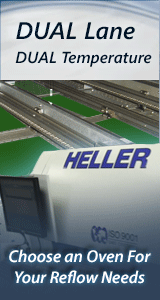Printed Circuit Board Assembly & PCB Design Forum
SMT electronics assembly manufacturing forum.
- SMTnet
- »
- Electronics Forum
- »
- TSOP40 Lead pitch 0.50mm recommended aperture sizes?
TSOP40 Lead pitch 0.50mm recommended aperture sizes?
![]() What are the recommended stencil apertures for a TSOP40.
Le...
- Mar 06, 2003
by
What are the recommended stencil apertures for a TSOP40.
Le...
- Mar 06, 2003
by
![]()
![]() Q1: What are the recommended stencil apertures for a TSOP40....
- Mar 07, 2003
by
davef
Q1: What are the recommended stencil apertures for a TSOP40....
- Mar 07, 2003
by
davef
![]()
![]()
![]() When printing below .5mm pitch, the recommended stencil thic...
- Mar 07, 2003
by
When printing below .5mm pitch, the recommended stencil thic...
- Mar 07, 2003
by
![]()
![]()
![]() Mark,
You've already received some good advice from the o...
- Mar 08, 2003
by
Mark,
You've already received some good advice from the o...
- Mar 08, 2003
by
![]()
![]() I'm wrong about the MPM AP. I got my model designation cros...
- Mar 11, 2003
by
davef
I'm wrong about the MPM AP. I got my model designation cros...
- Mar 11, 2003
by
davef
![]()
Mark
- SMTnet
- »
- Electronics Forum
- »
- TSOP40 Lead pitch 0.50mm recommended aperture sizes?








